 W
WArena of Antares is a science fiction novel by British writer Kenneth Bulmer, written under the pseudonym of Alan Burt Akers; it is the seventh volume in his Dray Prescot series of sword and planet novels, set on the fictional world of Kregen, a planet of the Antares star system in the constellation of Scorpio. It was first published by DAW Books in 1974.
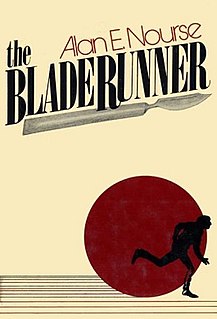 W
WThe novel The Bladerunner is a 1974 science fiction novel by Alan E. Nourse, about underground medical services and smuggling. It was the source for the name, but no major plot elements, of the 1982 film Blade Runner, adapted from the novel Do Androids Dream of Electric Sheep? by Philip K. Dick, though elements of the Nourse novel recur in a pair of 2002 films also largely adapted from Dick's work, Impostor and Minority Report.
 W
WBy the Light of the Green Star is a science fantasy novel by American writer Lin Carter. Published by DAW Books in 1974, it is the third novel in his Green Star Series. In this installment, other races of Green Star planet humans are introduced.
 W
WThe Centauri Device is the third novel by English author M. John Harrison. The novel, originally conceived as an "anti-space opera" would ultimately go on to make a major contribution to revitalising the subgenre and influencing the works of later authors such as Iain M. Banks and Alastair Reynolds.
 W
WThe Clockwork Testament is a novella by the British author Anthony Burgess. It is the third of Burgess' four Enderby novels and was first published in 1974 by Hart-Davis, MacGibbon Publishers. It is usually subtitled Enderby's End, as it was originally intended to be the last book in the Enderby series. However, a further sequel, Enderby's Dark Lady, followed in 1984.
 W
WDanny Dunn, Invisible Boy is the thirteenth novel in the Danny Dunn series of juvenile science fiction/adventure books written by Raymond Abrashkin and Jay Williams. The book was first published in 1974.
 W
WDhalgren is a 1975 science fiction novel by American writer Samuel R. Delany. It features an extended trip to and through Bellona, a fictional city in the American Midwest cut off from the rest of the world by an unknown catastrophe.
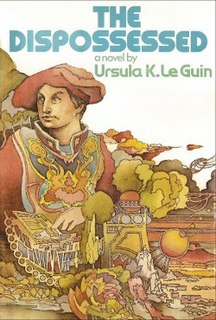 W
WThe Dispossessed: An Ambiguous Utopia is a 1974 utopian science fiction novel by American writer Ursula K. Le Guin, set in the fictional universe of the seven novels of the Hainish Cycle, e.g. The Left Hand of Darkness. The book won the Nebula Award for Best Novel in 1974, as well as winning both the Hugo and Locus Awards in 1975, and received a nomination for the John W. Campbell Memorial Award in 1975. It achieved a degree of literary recognition unusual for science fiction due to its exploration of themes such as anarchism and revolutionary societies, capitalism, and individualism and collectivism.
 W
WThe Dream Millennium is a 1974 science fiction novel by Northern Irish writer James White. The plot revolves around the captain of a starship who, along with the rest of the people on board, is fleeing a dystopian Earth, with the launch taking place around the year 2170.
 W
WThe Fall of Chronopolis (ISBN 0-87997-043-X) is the fifth novel by the science fiction author Barrington J. Bayley. It details the eternal conflict through time between the Chronostatic Empire and its enemy, the Hegemony.
 W
WThe Fall of Colossus is a 1974 science fiction novel written by the British author Dennis Feltham Jones. This is the second volume in "The Colossus Trilogy" and a sequel to Jones' 1966 novel Colossus.
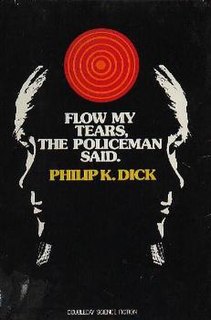 W
WFlow My Tears, the Policeman Said is a 1974 science fiction novel by American writer Philip K. Dick. The novel is set in a futuristic dystopia where the United States has become a police state in the aftermath of a Second Civil War. The story follows genetically enhanced pop singer and television star Jason Taverner who wakes up in a world where he has never existed. The book was nominated for a Nebula Award in 1974 and a Hugo Award in 1975, and was awarded the John W. Campbell Memorial Award for Best Science Fiction Novel in 1975.
 W
WThe Forever War (1974) is a military science fiction novel by American author Joe Haldeman, telling the contemplative story about human soldiers fighting an interstellar war against an alien civilization known as the Taurans. It won the Nebula Award in 1975 and the Hugo and Locus awards in 1976. Forever Free (1999) and Forever Peace (1997) are respectively, direct and thematic sequel novels. The novella A Separate War (1999) is another sequel of sorts, occurring simultaneously with the final portion of The Forever War. Informally, the novels comprise The Forever War series; the novel also inspired a comic book and a board game. The Forever War is the first title in the SF Masterworks series.
 W
WThe Godwhale is a science fiction novel by American novelist T. J. Bass, first published in 1974. It is the sequel to Half Past Human. The book was nominated for the Nebula Award for Best Novel in 1974. The novel deals with genetic and biological inventions with a strange and mystical twist.
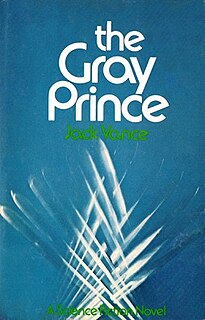 W
WThe Gray Prince is a science fiction novel by American writer Jack Vance, first published in two parts in Amazing Science Fiction magazine with the title The Domains of Koryphon. Given that the novel's setting, the planet Koryphon, is integral to the plot, The Gray Prince may be said to belong to the science fiction subgenre of the planetary romance. Also significant in this regard is the work's original title, The Domains of Koryphon, which gives prominence to the setting of the conflict narrated in the novel rather than to one of its many characters.
 W
WHigh Crystal is a science fiction/secret agent novel by Martin Caidin that was first published in 1974. It was the second sequel to Caidin's 1972 work Cyborg, which in turn was the basis for the television series The Six Million Dollar Man. Although published after the start of the television series, the book does not share continuity with it.
 W
WHouse of Stairs (1974) is a science fiction novel by William Sleator about orphaned teenagers placed in a house of stairs, similar to the lithograph print by M. C. Escher, which provided the novel's title and setting, in a psychological exploitation of a social dynamics experiment.
 W
WIcerigger is a 1974 science fiction novel by American writer Alan Dean Foster. Like many of Foster's science-fiction novels, Icerigger takes place within his Humanx Commonwealth fictional universe. The book's two sequels are Mission to Moulokin and The Deluge Drivers.
 W
WInverted World is a 1974 science fiction novel by British writer Christopher Priest, expanded from a short story by the same name included in New Writings in SF 22 (1973). In 2010, it was included in the SF Masterworks collection.
 W
WDas Königsprojekt is a German-language science fiction novel by Carl Amery, published in 1974. The book was the first of three Science Fiction novels written by Amery.
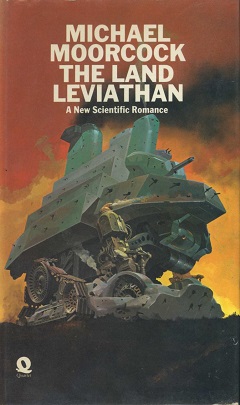 W
WThe Land Leviathan is an alternate history novel by Michael Moorcock, first published in 1974. Originally subtitled A New Scientific Romance, it has been seen as an early steampunk novel, dealing with an alternative British Imperial history dominated by airships and futuristic warfare. It is a sequel to Warlord of the Air (1971) and followed by The Steel Tsar (1981). This proto-steampunk trilogy is also published as the compilation volume A Nomad of the Time Streams.
 W
WThe Last Canadian is a 1974 science fiction novel by William C. Heine about the adventures of Eugene Arnprior after North America is devastated by a plague. The U.S. release of the novel was titled Death Wind.
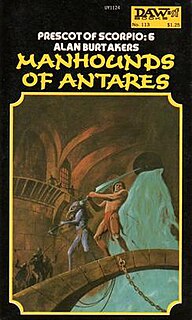 W
WManhounds of Antares is a science fiction novel by British writer Kenneth Bulmer, written under the pseudonym of Alan Burt Akers. It is the sixth volume in his Dray Prescot series of sword and planet novels, set on the fictional world of Kregen, a planet of the Antares star system in the constellation of Scorpio. It was first published by DAW Books in 1974.
 W
WThe Memoirs of a Survivor is a dystopian novel by Nobel Prize-winner Doris Lessing. It was first published in 1974 by Octagon Press. It was made into a film in 1981, starring Julie Christie and Nigel Hawthorne, and directed by David Gladwell.
 W
WMonument is a science fiction novel written by Lloyd Biggle, Jr. and published in 1974.
 W
WThe Mote in God's Eye is a science fiction novel by American writers Larry Niven and Jerry Pournelle, first published in 1974. The story is set in the distant future of Pournelle's CoDominium universe, and charts the first contact between humanity and an alien species. The title of the novel is a wordplay on the Biblical "The Mote and the Beam" parable and is the nickname of a star. The Mote in God's Eye was nominated for the Hugo, Nebula and Locus Awards in 1975.
 W
WPrince of Scorpio is a science fiction novel written by Kenneth Bulmer under the pseudonym of Alan Burt Akers. It is the fifth book in his extensive Dray Prescot series of sword and planet novels, set on the fictional world of Kregen, a planet of the Antares star system in the constellation of Scorpio. It was first published by DAW Books in 1974.
 W
WThe Rats (1974) is a horror novel by British writer James Herbert. This was Herbert's first novel and included graphic depictions of death and mutilation. A film adaptation was made in 1982, called Deadly Eyes. A 1985 adventure game for the Commodore 64 and ZX Spectrum based on the book was published by Hodder & Stoughton Ltd and produced by GXT. The Rats was followed by three sequels, Lair (1979), Domain (1984) and The City (1993). All three books were sold as a trilogy and were very well received by the public and horror fans.
 W
WThe Reincarnation of Peter Proud was written by popular fiction author Max Ehrlich. It was published in 1974 by Bobbs-Merrill and a year later by Bantam.
 W
WThe Soul of the Robot is the sixth science fiction novel by Barrington J. Bayley, featuring the character Jasperodus from his 1956 story "Fugitive". The book tells of Jasperodus, the only robot with a soul, as he attempts to prove that he is the equal of the humans around him. It was published in 1974 by Doubleday, with a revised version published in 1976 by Allison and Busby.
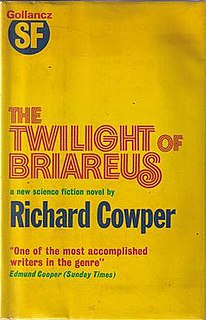 W
WThe Twilight of Briareus is a science-fiction novel by John Middleton Murry, Jr., under his pseudonym Richard Cowper. It "combine[s] disaster and invasion themes". One critic sees it as the book that Cowper's other novels resemble at heart.
 W
WThe Valley Where Time Stood Still is a science fantasy novel by American writer Lin Carter, the second in his Edgar Rice Burroughs- and Leigh Brackett-inspired series The Mysteries of Mars. It was first published in hardcover by Doubleday in December 1974 and in paperback by Popular Library in February 1976. It was reissued by Wildside Press in April 2008.
 W
WZ for Zachariah is a post-apocalyptic science-fiction novel by Robert C. O'Brien that was published posthumously in 1974. The name Robert C. O'Brien was the pen name used by Robert Leslie Conly. After the author's death in 1973, his wife Sally M. Conly and daughter Jane Leslie Conly completed the book guided by his notes. Set in the United States, the story is in the form of a diary written from the first-person perspective of sixteen-year-old Ann Burden, who has survived a nuclear war and nerve gas through living in a small valley with a self-contained weather system.